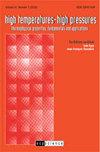Modeling thermodynamic properties of Ni, Sn, Al and Cu nanosolids
IF 0.6
4区 工程技术
Q4 Engineering
引用次数: 0
Abstract
Surface atoms and dangling bonds on the surface affect the thermodynamic properties. A thermodynamical model, based on cohesive energy is presented to discuss the melting properties of materials at nanoscale. The model is used to realize the effect of size and shape on melting temperature Tmn, melting entropy Smn and enthalpy Hmn of Ni, Sn, Al and Cu metallic nanoparticles. The variation in Tmn, Smn and Hmn are examined for nanowire, film, spherical, regular tetrahedral, hexahedral and octahedral shaped nanoparticles. It is reported that Tmn, Smn and Hmn decrease with decreasing the size of the nanoparticles and smaller the particle size, greater are the size and shape effects and when size is less than 10 nm, it has been predicted that on decreasing size, Tmn, Smn and Hmn reduce appreciably. Also, at the same size, more the shape of nanoparticles departs from that of the sphere, smaller is the Smn and Hmn of nanoparticles and its changes are less for nanowire shape and more for regular tetrahedral shape. Our theoretical results are compared with the available experimental or simulation data. Results predicted by our model are in good agreement with experimental observations.Ni, Sn, Al和Cu纳米固体的热力学性质建模
表面原子和悬空键会影响材料的热力学性质。提出了一种基于内聚能的热力学模型来讨论材料在纳米尺度上的熔化特性。利用该模型研究了尺寸和形状对Ni、Sn、Al和Cu金属纳米颗粒熔化温度Tmn、熔化熵Smn和熔化焓Hmn的影响。研究了纳米线、薄膜、球形、正四面体、六面体和八面体纳米颗粒中Tmn、Smn和Hmn的变化。据报道,Tmn、Smn和Hmn随着纳米颗粒尺寸的减小而减小,粒径越小,尺寸和形状效应越大,当粒径小于10 nm时,预测随着粒径的减小,Tmn、Smn和Hmn明显减小。同时,在相同尺寸下,纳米颗粒的形状越偏离球形,纳米颗粒的Smn和Hmn越小,纳米线形状的变化越小,而正四面体形状的变化越大。我们的理论结果与现有的实验或模拟数据进行了比较。模型预测结果与实验观测结果吻合较好。
本文章由计算机程序翻译,如有差异,请以英文原文为准。
求助全文
约1分钟内获得全文
求助全文
来源期刊

High Temperatures-high Pressures
THERMODYNAMICS-MECHANICS
CiteScore
1.00
自引率
9.10%
发文量
6
期刊介绍:
High Temperatures – High Pressures (HTHP) is an international journal publishing original peer-reviewed papers devoted to experimental and theoretical studies on thermophysical properties of matter, as well as experimental and modelling solutions for applications where control of thermophysical properties is critical, e.g. additive manufacturing. These studies deal with thermodynamic, thermal, and mechanical behaviour of materials, including transport and radiative properties. The journal provides a platform for disseminating knowledge of thermophysical properties, their measurement, their applications, equipment and techniques. HTHP covers the thermophysical properties of gases, liquids, and solids at all temperatures and under all physical conditions, with special emphasis on matter and applications under extreme conditions, e.g. high temperatures and high pressures. Additionally, HTHP publishes authoritative reviews of advances in thermophysics research, critical compilations of existing data, new technology, and industrial applications, plus book reviews.
 求助内容:
求助内容: 应助结果提醒方式:
应助结果提醒方式:


